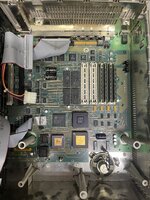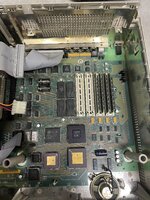Also, a couple notes with regards to tools, since there's a lot of conflicting information floating around online: contrary to what some guides imply, the latest and greatest soldering and test equipment are not a requirement for working on these 30+ year old machines. If you're happy with your current soldering iron for through-hole work, it's most likely sufficient for surface-mount components of the size found in 68k systems.
Biggest topic of contention with this stuff seems to be whether or not a hot air station is required for desoldering the old caps. Many people, myself included, have had perfect success removing the old caps by rocking the caps back and forth, until metal fatigue breaks the cap leads between the aluminum can and plastic base. So long as you're not pulling upwards on the cap, and the rocking action is perpendicular to the pads on the board, the chances of the pads lifting is fairly low. A hot air station *isn't* a requirement, although it is technically the "more correct" tool for the job. Beware that using hot air can cause the caps to puff up and explode. Worst case scenario, improper/inexperienced use of the hot air gun can render a board near-unrepairable due to scorching/warping/layer delamination due to trapped moisture in the board.
As far as cleaning the board goes, an ultrasonic cleaner is also not a strict requirement. Dish soap + a toothbrush followed by a rinse in distilled water is more than enough for most boards. It's a different story entirely for the people running board recapping services, who are dealing with multiple boards per week, and where time is of the essence.
Only other thing I can think of is, look also towards the broader electronics hobbyist community for soldering and repair tricks, outside the old Mac or vintage computing circles. Many great wealths of information out there too






